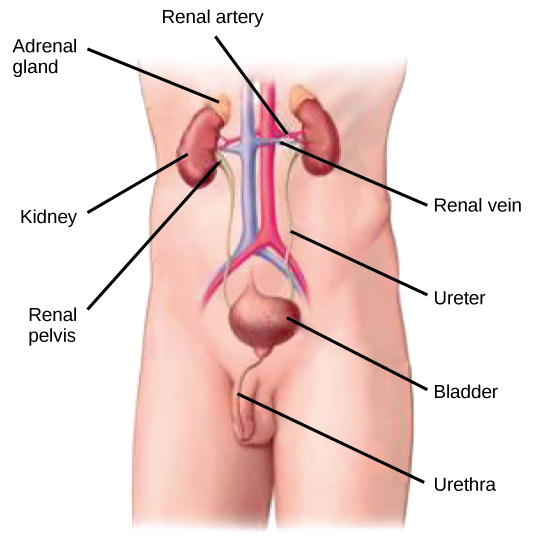| << Chapter < Page | Chapter >> Page > |
Although the kidneys are the major osmoregulatory organ, the skin and lungs also play a role in the process. Water and electrolytes are lost through sweat glands in the skin, which helps moisturize and cool the skin surface, while the lungs expel a small amount of water in the form of mucous secretions and via evaporation of water vapor.
The kidneys , illustrated in [link] , are a pair of bean-shaped structures that are located just below and posterior to the liver in the peritoneal cavity. The adrenal glands sit on top of each kidney and are also called the suprarenal glands. Kidneys filter blood and purify it. All the blood in the human body is filtered many times a day by the kidneys; these organs use up almost 25 percent of the oxygen absorbed through the lungs to perform this function. Oxygen allows the kidney cells to efficiently manufacture chemical energy in the form of ATP through aerobic respiration. The filtrate coming out of the kidneys is called urine .

Externally, the kidneys are surrounded by three layers, illustrated in [link] . The outermost layer is a tough connective tissue layer called the renal fascia . The second layer is called the perirenal fat capsule , which helps anchor the kidneys in place. The third and innermost layer is the renal capsule . Internally, the kidney has three regions—an outer cortex , a medulla in the middle, and the renal pelvis in the region called the hilum of the kidney. The hilum is the concave part of the bean-shape where blood vessels and nerves enter and exit the kidney; it is also the point of exit for the ureters. The renal cortex is granular due to the presence of nephrons —the functional unit of the kidney. The medulla consists of multiple pyramidal tissue masses, called the renal pyramids . In between the pyramids are spaces called renal columns through which the blood vessels pass. The tips of the pyramids, called renal papillae, point toward the renal pelvis. There are, on average, eight renal pyramids in each kidney. The renal pyramids along with the adjoining cortical region are called the lobes of the kidney . The renal pelvis leads to the ureter on the outside of the kidney. On the inside of the kidney, the renal pelvis branches out into two or three extensions called the major calyces , which further branch into the minor calyces. The ureters are urine-bearing tubes that exit the kidney and empty into the urinary bladder .

Notification Switch
Would you like to follow the 'Biology' conversation and receive update notifications?